 1. Discovery |
 1. Discovery |
I first saw the tail vertebrae of Seismosaurus on a hot day in May 1985. The bones lay partially exposed on a sandstone ledge ten feet below the top of a small mesa. The cliff face beyond the ledge reflected the desert sun with blinding brilliance. A hundred feet below, in the valley carved by the drainage called Bernallilito Wash, I could see the rubble that had accumulated by the erosion of these steep cliffs. In all directions arroyos and mesas displayed the vivid colors of Jurassic and Cretaceous sediments in a dazzling array of brown and tan sandstones and green, red, and black shales, all covered by desert scrub and patches of piñon pines and western juniper.
Mute and nameless, the bones lay only a hundred feet away from several panels of vivid rock carvings, perhaps a thousand years old. These figures of snakes and turtles and strange gangly men, chipped into the red, iron-stained rind of the sandstone, had brought us together.
What had the makers of these petroglyphs witnessed in the valley below? Had their ancestors, ten thousand years ago, stalked mammoths and ground sloths from this sentinel? Did the rock carvers warm themselves in the winter sun on this south-facing ledge as they waited and watched for smaller game? And did they see and wonder about the bones in the rock--perhaps the rearward bones of the tail then exposed but now long since eroded away?
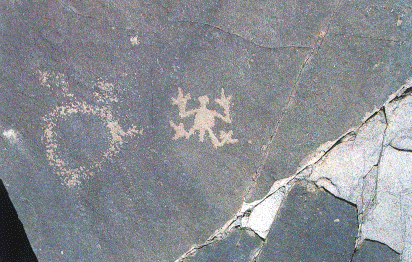 |
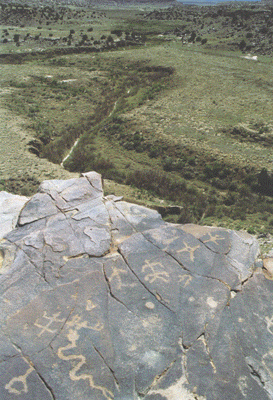 |
| Petroglyphs near the Seismosaurus site. These rock carvings were produced by the Anasazi, who occupied the Southwest before modern Native Americans. |
The petroglyphs offer no clue. Their makers, the mysterious Anasazi, are gone. But perhaps the artists did see bones, then as now, eroding slowly out of the softer matrix. Perhaps they too stood in awe before them.
In 1979 two hikers, Arthur Loy and Jan Cummings, both from Albuquerque, were bound for these petroglyphs about sixty miles west of the city. Years earlier in the heyday of uranium exploration, a road had been graded to the mesa that stretched westward like a long peninsula. Now the road was little more than a trail used by hikers in the Ojito Wilderness Study Area. Pronounced "oh-HEE-toe," the name means "little spring" in Spanish. In this high-elevation desert of central New Mexico, even small springs can give a whole region a name.
Jan and Arthur picked out different routes through the rocks and juniper along the south face of the mesa. It was Arthur who saw them first: a line of backbones lying on their sides in the sandstone, looking like a carving in bas relief, half buried and half exposed to the desert sun. He hesitated a moment, stunned by this unexpected bonus in their hike. Then he called to his friend at the top of the mesa, "Hey, Jan, what do you make of this?"
Arthur was a music teacher, Jan a former geologist and now part-time pharmacist. Jan knew in a moment that these were bones of a dinosaur. But he was surprised because he hadn't heard of any dinosaurs in this part of New Mexico. The nearest were more than a hundred miles away, and in rocks of Cretaceous age; these rocks were Jurassic--much older. The bones triggered a rush of questions: what kind of dinosaur? what part of the backbone were they looking at? how could the vertebrae have been so beautifully preserved, still articulated, one to the next? and were there more bones below?
I don't know whether Jan and Arthur got to the petroglyphs that day. I suppose they did, as the carvings are only a hundred feet away on the edge of the mesa. But I do know that they did not forget the bones. A few weeks later they told their close hiking friends Bill Norlander and Frank Walker about the relics of the Ojito site. When the four found a free weekend to return to the site, Frank took a camera. Unmovable in their sandstone vault, the bones were recorded on film.
Later these four explorers showed the photographs, and then the site itself, to paleontologists who work for the federal government. The Ojito Wilderness Study Area is federal property, managed by the U.S. Bureau of Land Management. Moreover, bone collecting is strictly regulated on government property. One paleontologist confirmed their identification of the bones as those of a dinosaur--a sauropod, kin to Diplodocus. But the sandstone would be too hard to chip with hand tools--dynamite would be necessary. Excavation would not come any time soon. Disappointed, Arthur, Jan, Frank, and Bill piled rocks over the bones to protect them from further weathering and, more important, to hide them from marauding collectors.
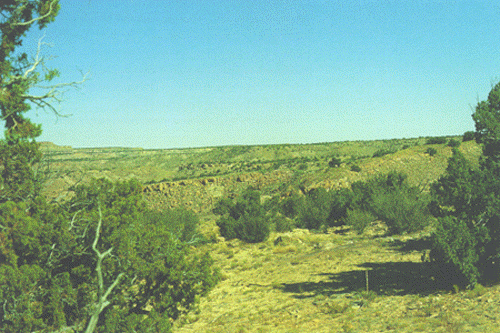
Panorama photograph of the Ojito Wilderness Study Area (from the south). The fossil site is in the low mesa capped by juniper and piñon trees in the midground.
Six years later Frank Walker reported the find to a state institution: the New Mexico Museum of Natural History, located in Albuquerque. I was then in my third year as curator of paleontology for this new state museum. The ongoing construction was getting a lot of local publicity, and every week I had been getting dozens of phone calls reporting dinosaur discoveries. I had to screen each call to determine whether the reports were credible. Frank told me that his friend Jan was trained in geology and that he had identified the geological setting as the Morrison Formation. Frank told me, too, of the confirmation of that identification by the BLM paleontologist. Frank's description of nearly white, fully articulated bones made me suspicious, however.
I was diplomatic. "There aren't any Morrison dinosaurs known in the area," I told him, "except one partial skeleton excavated several years ago. Otherwise, the closest Morrison dinosaurs are mostly just fragments from eastern New Mexico, two hundred miles away."
Frank was insistent. He offered to show me the snapshots, and if I was interested he would guide me to the site. Next day Frank brought his photos to the museum, and I was immediately convinced. Clearly visible were several vertebrae laid out end to end in a stark white sandstone. They were large, even for dinosaur bones, but from the photos I couldn't tell which part of the body they were from or identify which dinosaur they belong to.
Frank then told me that a television crew for a local documentary news program had filmed the site and that the footage had aired two weeks ago. The public had thus seen the bones in all their splendid detail. He was worried that unscrupulous collectors might now be planning a raid; hence his call. I, too, was alarmed. Frank agreed to take me to the site the next day.
As we drove northwest out of Albuquerque and past the Zia Indian Reservation, towering cumulus clouds gathered to the north over the Jemez Mountains. In these mountains a giant caldera more than twenty miles across is all that remains of what had been a magnificent volcano hundreds of thousands of years ago. The churning clouds now threatened to deliver a payload of thunder, lightning, and flashfloods.
We left the highway and turned west onto a well-maintained gravel road. Within a mile we passed small hills that displayed the awesome power of the earth's crustal motions. What was now the Rio Grande region had once been a major rift and fault zone, as dramatic and powerful in its past volcanic activity and earth movement as is the Great Rift Valley of eastern Africa today. Layers of rocks had been locally folded, contorted, upended, and then eroded into a panorama of rich and banded colors: tan, deep purple, brown, white, and red, all incised with gullies and canyons. The line of the fault could be traced to the horizon and beyond for more than a hundred miles. It marked the boundary between two of the major physiographic provinces of North America. We were leaving the Rio Grande Rift and entering the southeastern corner of the Colorado Plateau.
Further down the road the landscape opened into a maze of buttes and broader flat-topped mesas. Some of the mesas were gouged by canyons lined with the deep green hues of juniper shrubs and piñon pines--a welcome contrast to the earth tones of the surrounding desert. I began to identify the geological strata for Frank. The prominent brown layer capping the highest mesas (giving them their characteristic table-top form) is the Dakota Sandstone. Beneath the Dakota lies the softer Mancos Shale, its gray mudstones eroding in gentle slopes too unstable to hold vegetation. Elsewhere in New Mexico these two formations of the Cretaceous Period yield shark teeth and dinosaur tracks a hundred million years old.
The road twisted through a deep canyon, with its own smaller side canyons carved by flash floods. These arroyos had cut through the Mancos Shale and down into the darker Morrison Formation, the youngest of the various Jurassic formations in North America. Its mostly purple and brown sandstones, siltstones, and mudstones were dotted with spring desert flowers. I was pleased: Frank had the geology correctly identified, thanks to Jan. These formations extended across northern New Mexico west into Arizona, east into Texas, and north as far as Utah and Montana. Elsewhere these rocks, especially the Morrison Formation, had yielded a bounty of dinosaurs, but not in New Mexico--at least not yet. I dared to imagine that Frank was taking me to a new bonanza in the Morrison.
Frank turned his pickup off the gravel road and followed the faint tracks of a jeep trail, the same track that Jan and Arthur had used six years earlier. Rain would be welcome, but I hoped the storm would wait till we got back to the highway. Sandy portions of the track showed evidence of recent traffic. A mile farther, after jostling over the rocks and ledges, we parked the truck. There we found more tracks in the sand and the mix of trash one sadly finds just about anywhere vehicles can go.
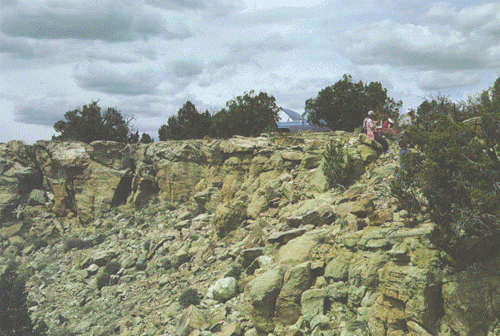
A closer view of the Seismosaurus site. The resistant sandstone of the cliff face (which was about thirty feet west of the skeleton) is in the upper part of the Morrison Formation, technically called the Brushy Basin Member.
We stopped a hundred yards short of the end of the mesa, on the edge of a barren sandstone ledge. Frank motioned to get out of the truck. I scanned the horizon to line up our mesa with others in the distance. Some high mesas were capped by Dakota sandstone; others, like the low mesa where we had stopped, were capped by resistant sandstones of the underlying Morrison Formation. We were clearly in the Morrison Formation.
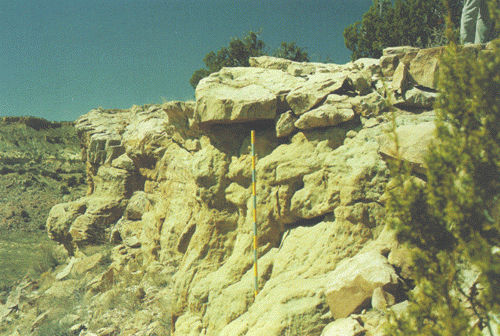
Close-up view of the ledge just before excavation. The rod in the center of the photograph is two meters tall; the bones lay entombed in the sandstone to the right.
The initial identification had been correct: a sauropod dinosaur, akin
to Apatosaurus and Diplodocus. The huge centrum for each vertebra and the
tall and erect dorsal spines of great size proved the identification. I
estimated that each vertebra was about a foot long. But I couldn't see
enough to conclude anything more specific. The only sauropod known from
the Morrison in this part of New Mexico was the much smaller
Camarasaurus, and since I was working with dinosaur sculptor and museum
technician Dave Thomas mounting a Camarasaurus skeleton for exhibit I had
no doubt that the Ojito dinosaur was different and therefore new to New
Mexico. But I did not expect it to be new to science.
I knew we had to excavate these bones--immediately. But there were
problems: this was a wilderness study area. Ten thousand acres of the
Ojito region were being studied for potential designation as a federally
protected wilderness, and during this time strict rules to prevent its
degradation were in force. The Bureau of Land Management typically took a
year or more to process an excavation permit request for even
unrestricted lands; who could predict how long they would take for a
wilderness study area? I could imagine rock hounds scouring the area for
souvenirs, tipped off by the television publicity, and haulingaway in their knapsacks what should be studied and
displayed at the new museum--as we dutifully waited for our permit.
At the BLM office in Albuquerque I asked for immediate approval of our
application so that a crew from the museum could excavate on Father's Day
weekend, only three weeks away. I, of course, told them all the reasons
why expeditious treatment was warranted in this case. But I knew my
request was unrealistic: to my knowledge no BLM permit for fossil
collecting had ever been issued in such a short time. The application had
to get clearance from geologists, archaeologists, biologists charged with
protecting rare and endangered species, reclamation specialists,
recreation specialists, and outside wilderness advisers.
Two weeks later a BLM official called with the news that we could proceed with the excavation as requested. I was as
thrilled as I was surprised. We were faced with a few restrictions
relating to access and use of equipment, but these demands were
reasonable. Immediately, I began to organize a field crew.
It was not, however, the best of times to do so. Construction of
exhibits at the museum had reached a frantic pace, and all other concerns
were set aside. Curators like me, whose responsibilities included
research and collection management, were ordered to wield hammer and saw,
or broom and bucket, and join in the madness. At the same time I was
managing about fifty outside contracts, all related in some way to
paleontology exhibits. We had to schedule the emergency excavation for a
long weekend, on off-duty time. Father's Day it would have to be.
My wife, Lynett Gillette (who is also a paleontologist specializing in
dinosaurs), and Jennifer Gillette, our thirteen-year-old daughter,
happily went along with the idea of a dinosaur excavation for our
Father's Day plans. Museum sculptor and paleontological technician Dave
Thomas celebrated Father's Day on site too. Several BLM employees chose
to join us, including recreation specialist Angie Burger and Dennis
Umshler, a geologist who would later guide us through additional permit
applications. Dennis agreed to be photographer for the weekend. Rounding
out the crew was an assortment of volunteers from the fledgling and
informally organized New Mexico Friends of Paleontology. The original
discovery team--Arthur, Jan, Frank, and Bill--were also honored guests
and helpers.
The size of the crew matched the size of the job, which we were going
to do without dynamite. In my experience excavation of bones this size
entailed considerable labor and no small amount of seat-of-the-pants
engineering. But I saw no reason to consider dynamite--a tactic that
would have set off alarm bells for those processing the permit. My plan
was to use small jackhammers powered by generators to expose blocks of
rock around the bones. The blocks would then be wrapped in plaster-soaked
burlap for transport. Pickup trucks would be sufficient for hauling
everything in and out, and we needed little else except lots of drinking
water, brimmed hats, and sunscreen.
We arrived early on Saturday morning. Each participant had one or more
specific jobs: digging, operating a jackhammer, mapping and note taking,
cutting burlap sacks into strips, preparing plaster, taking photographs.
In the heat and surrounded by gnats, we set to work.
The sandstone was hard around the bones, softer a few inches away.
This made the digging easier than we expected. By midmorning we had
outlined eight vertebrae, following the bones deep into the rock to
determine their limits. Next we selected where to make the separations in
the string of vertebrae and how to undercut the blocks for plastering.
Where possible we used natural cracks in the rock--sometimes opting to
break the blocks by way of a natural fracture running right through a
bone rather than attempting to force a break (and thus risk additional
fracturing) between articulated bones. Repairs could be made in the
laboratory, and the breaks matched with precision.
By midafternoon Sunday we had isolated all the exposed bones. We then
wrapped them in plaster and burlap. Several blocks weighed as much as
four hundred pounds. After securing the blocks in plaster and burlap, we
loaded them onto a trailer and pickup trucks, using four or five strong
people for each block. Tires bulging and springs
overstressed, our trucks and the trailer made the slow trip back to
Albuquerque as the sun set.
Two long days of excavation proved to be just the right amount of time
for removal of the exposed bones. The excavation revealed that these
bones came from the middle part of the tail, but their exact position
could not be established until laboratory preparation--a tedious and
time-consuming process--was completed. Little did I realize that those
two days were to lead to months and years of work at the site, excavating
more bones in collaboration with dozens of other research scientists.
I suspected that the line of the tail would continue into the mesa and
that it might, if we were very lucky, lead to the rest of the body. One
partly exposed bone fragment at one end of the original line of vertebrae
suggested that the eight bones we removed that weekend were not the only
bones there. Only a few square inches of that mystery bone were exposed,
and I didn't want to jeopardize its security in the rock by exposing the
bone further without doing a job sufficient for collecting it. By Sunday
afternoon we realized we couldn't expect to collect any more bone on that
initial outing and that expanding the quarry was not practical.
That bone fragment became an impetus and a marker for future
excavations. Along with the fact that the collected vertebrae were
perfectly articulated, this fragment was tangible evidence that more bone
might be present. On it hung our best chance for securing the kind of
financial assistance that a full excavation would demand.
We stored the plaster jackets containing the bones in the garage of
one of the volunteers, as I was uncertain how to proceed. I was
overloaded already with my share of exhibit and construction management
at the museum and could not even consider beginning careful work on the
bones in the paleontology laboratory. Nor would space be available to
store the massive blocks in the new building.
Dennis Umshler called a few weeks later with disappointing news. None
of his photographs were properly exposed. Our official photographic
record of the initial excavation had been lost to the dual distractions
of gnats and heat.
"Don't worry," I reassured him. "This was just a routine excavation,
and I understand that some of the other volunteers got a few snapshots."
The excavation had been conducted under my guidance, but it had
required the gift of many people's labor. The matter of identification
was now my responsibility alone. The identity of this dinosaur was,
however, still a puzzle to me. At the time I suspected that the
specimen's prime value was not its identity but the facts that its bones
were articulated and it was new to New Mexico. Dinosaur bones are usually
scattered and disconnected, owing to the work of scavengers or to stream
action. Only rarely do we find bones connected, and even then the
skeletons are seldom complete.
Even specialists cannot always identify a fossil with confidence at
the time of discovery. This was my first experience with a sauropod
dinosaur skeleton. Paleontologists usually try to make a reasonable guess
as to the level of family or genus, and we are often correct, but unless
the diagnostic traits are evident on site, firm identification must await
laboratory analysis. In the case of an organism new to science, our usual
first reaction is puzzlement, as we try to relate the observed
characteristics to what we know about established genera or species. The
recognition of a new taxon almost never occurs at the time of discovery.
This sauropod dinosaur clearly belonged to the family Diplodocidae, but
whether it was Diplodocus, Apatosaurus, Barosaurus, or one of the other
lesser-known genera or a new genus altogether was unclear. I could
resolve this problem only by comparing these bones to sauropod bones in
other collections.
In the meantime this partial, but articulated skeleton would become
the focal point for more discussion than any other dinosaur I had ever
excavated. Before taking my position at the new museum in 1983, I had
spent twenty years specializing in Ice Age animals, Cretaceous sharks and
fish, and the natural history of vertebrates. In this new post I expanded
my research goals to include dinosaurs. By the time of our excavation I
had studied thousands of dinosaur tracks, including those of sauropods,
and I had excavated a partial skull of Tyrannosaurus rex and
perhaps a dozen other dinosaur skeletons and partial skeletons. Since then I have worked in all three periods of the
Mesozoic (Triassic, Jurassic, and Cretaceous) on hundreds of dinosaur
skeletons, mainly in Utah and New Mexico. But this excavation has been
the most important.
Names are essential for communication. Unable yet to give these bones
a scientific name, I needed at least a familiar name. I could have
referred to the skeleton by catalog number NMMNH 3690 (New Mexico Museum
of Natural History paleontology specimen number 3690), or by a field
number that would correspond to notes taken during the excavation. But
like paleoanthropologists working on hominids in Africa, I felt the need
for something more personal, more familiar. Lucy got her name from a
famous Beatles song popular at the time of discovery; Twiggy was an
obvious name for a hominid with a flattened cranium found at a time when
the fashion industry's most famous model was so named for her twiglike,
flattened physique. Even something purely geographic (for example, the
Taung baby) would suffice.
My choice for the Ojito dinosaur was Sam. A common nickname for
Samantha or Samuel, it was appropriately ambivalent for an individual
dinosaur that was, as yet, known from just eight bones. But soon it would
be time to give Sam a proper scientific name.
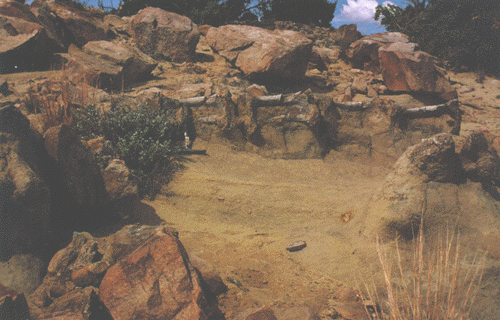
The tail vertebrae as originally
discovered. From this perspective the bottom surfaces of four articulated
vertebrae, each about twelve inches long, can be discerned. (The carcass
came to rest on its side before burial.) Photograph courtesy of Frank
Walker.
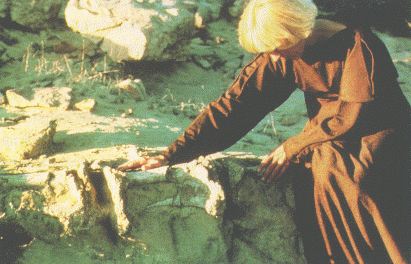
Closer view of the bottom surfaces of two
of the original tail vertebrae. Photograph courtesy of Frank
Walker.
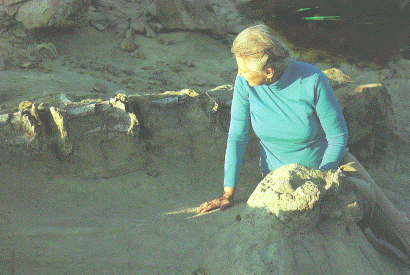
Tail vertebrae. The mound in front of the
woman contained several heavily weathered vertebrae that had slipped from
their original positions before burial. Photograph courtesy of Frank
Walker.
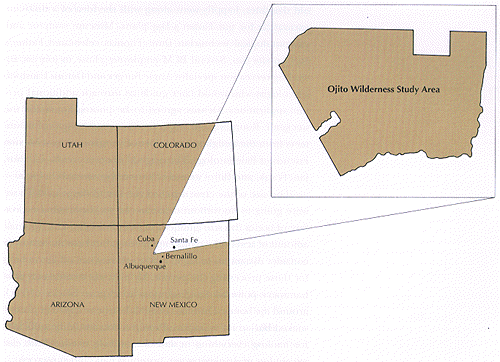
Location map. The Ojito Wilderness Study
Area is in northwestern New Mexico about sixty miles northwest of
Albuquerque.
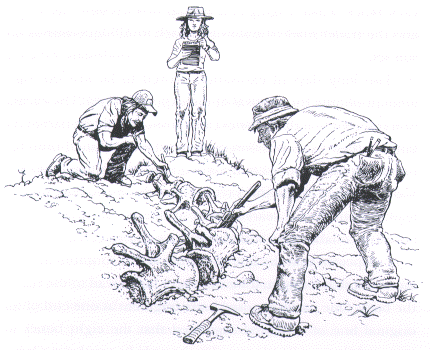
Initial excavation in 1985. This drawing
is based on the only surviving photograph.